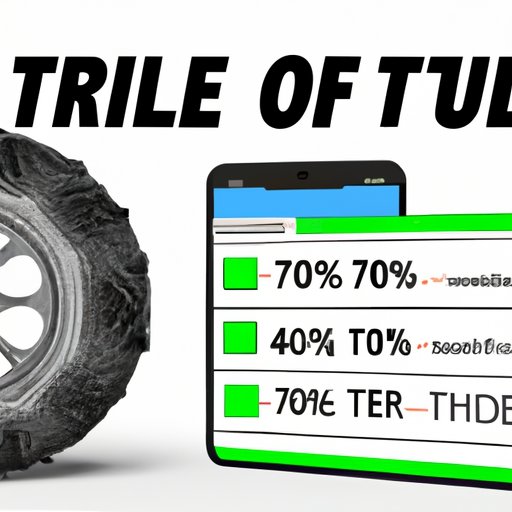
I. Introduction
One of the most important aspects of keeping your vehicle safe is knowing how to check your tire size. Many drivers disregard this crucial step, assuming that their existing tires are fine or that they can simply look at their car manual. However, knowing your tire size can help you avoid potential dangers, improve performance, and ensure that you’re driving on the right kind of tires for your vehicle type. In this guide, we’ll cover everything you need to know about checking your tire size, including step-by-step instructions, load rating tips, online calculator recommendations, and tire size myths debunked.
II. A step-by-step guide for finding your tire size
Checking your tire size is relatively easy, as long as you know where to look. Most vehicles have the tire size information located on the sidewall of the tire. You can typically find the information on the outer sidewall of the tire, near the tire’s bead (where it meets the wheel). Look for a sequence of numbers and letters that look something like this:
P225/50R17 90H
The sequence includes a combination of three numbers and two letters, each of which represents a specific piece of information about the tire. Here’s a breakdown of what each number and letter means:
- The first number (225) represents the width of the tire in millimeters.
- The second number (50) represents the aspect ratio or profile of the tire.
- The letter (R) indicates that the tire type is radial.
- The next number (17) represents the diameter of the wheel or rim in inches.
- The last two letters (90H) represent the load rating and speed rating of the tire.
When comparing tires for replacement, it’s important to match all elements of the sequence, not just the first three numbers. The load and speed ratings are also essential components to consider.
III. The importance of checking your tire size
Ignoring or neglecting your tire size could lead to serious consequences, including decreased handling and stability, as well as decreased fuel efficiency. Additionally, installing the wrong sized or wrong type of tire could lead to blowouts, reduced braking capacity, and increased risk of accidents. To avoid these hazards, it’s necessary to double-check your tire size regularly. Checking your tire size ensures that your tires will function correctly on the road, providing you with safety and reliability.
IV. Different types of tire sizes
There are three types of tire sizes: metric, alpha-numeric, and p-metric. Metric tire sizes are the most common, whereas alpha-numeric tire sizes are more prevalent on older cars (those manufactured in the early 1980s or earlier). P-metric tire sizes are commonly used for light trucks and SUVs and are also known as passenger metric or p-met. To identify tire size by type, simply look for the letter sequence on the sidewall of the tire. The type of tire size is usually the first letter in the sequence.
V. The impact of load ratings on your tire size
Load ratings and tire size are interconnected since several specifications, like tire width and aspect ratio, relate to how much load a tire is capable of handling. If your vehicle is carrying a heavy load, it’s crucial to ensure you have the right size tires with the correct load rating. The load rating itself is stamped on the tire and represents a weight limit for each tire model. To determine the right load rating, check your vehicle’s owner manual or consult with a certified tire dealer.
VI. How to use online tire size calculators
A rapid way to determine tire size is to use online tire size calculators offered by tire manufacturers and automotive retailers. These calculators require specific information that you can typically find on the sidewall of your tire, including width, aspect ratio, rim diameter, and speed rating, and then generate the tire size. It’s essential to note that results generated by online calculators aren’t always perfect and should be used as a rough estimate only.
VII. Tire size myths debunked
One of the biggest misconceptions about tires is that the exact size and type have to match that of the original manufacturer tires. However, this statement is not entirely accurate. Vehicles are capable of handling different sizes of tires, according to their load carrying capacity, cornering abilities, and other components. Talk to a tire dealer or licensed auto repair specialist when upgrading tire size to ensure that the right tire is chosen.
VIII. When to check your tire size
Checking your tire size should be done regularly as part of your general vehicle maintenance. It’s best to check tires every month, or before you go on a long trip, to prevent under- or over-inflated tires that can cause a range of problems. Additionally, inspect tire size if your vehicle’s handling seems off, the tire manufacturer recommends a particular tire size for a new product, or you need replacement tires.
IX. Conclusion
Practicing good tire maintenance and regularly checking your tire size is necessary for the longevity and safety of your vehicle. By using the guidance and resources outlined in this article, you’ll have the tools and knowledge to check your tire size and avoid potential hazards associated with under- or over-sized tires. Stay safe on the road and build road reliability with proper tire size checks and replacements, as well as regular maintenance.





